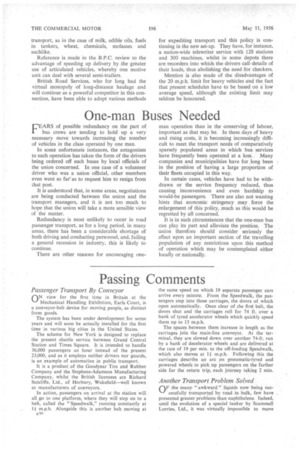Passing Comments
Page 38

Page 39

If you've noticed an error in this article please click here to report it so we can fix it.
Passenger Transport By Conveyor
nN view for the first time in Britain at the Mechanical Handling Exhibition, Earls Court, is a conveyor-belt device for moving people, as distinct from goods.
The system has been under development for some years and will soon be actually installed for the first time in various big cities in the United States.
The scheme for New York is designed to replace the present shuttle service between Grand Central Station and Times Square. It is intended to handle 36,000 passengers an hour instead of the present 23,000, and as it employs neither drivers nor guards, is an example of automation in public transport.
It is a product of the Goodyear Tire and Rubber Company and the Stephens-Adamson Manufacturing Company, whilst the British licensees are Richard Sutcliffe, Ltd., of Horbury, Wakefield—well known as manufacturers of conveyors.
In action, passengers on arrival at the station will all go to one platform, where they will step on to a belt, called the "Speedwalk," running constantly at 14m.p.h. Alongside this is another belt moving at 133n
the same speed on which 19 separate passenger cars arrive every minute. From the Speedwalk, the passengers step into these carriages, the doors of .which open automatically. Once clear of the first belt, the doors shut and the carriages roll for 74 ft. over a bank of tyred accelerator wheels which quickly speed them up to 15 m.p.h.
The spaces between them increase in length as the carriages join the main-line conveyor. At the terminal, they are slowed down over another 74-ft. run by a bank of decelerator wheels and are delivered at the rate of 19 per min. to the off-loading Speedwalk, which also moves at 1+ m.p.h. Following this the carriages describe an arc pn pneumatic-tyred and powered wheels to pick up passengers on the farther side for the return trip, each journey taking 2 min.
Another Transport Problem Solved
nF the many " awkward " liquids now being suc
cessfully transported by road in bulk, few have presented greater problems than naphthalene. Indeed, until the evolution of a special tanker by Scarnmell Lorries, Ltd, it was virtually impossible to move naphthalene (other than as moth balls, or crystallized flakes), because of its habit of solidifying at 176" F. Because it is possible for distilleries to produce naphthalene as a liquid, and as most chemical plants use it in liquid form, it is obviously an advantage to be able to transport the substance in its fluid state.
Further advantages result from this: it is far cleaner and neater to load and unload in liquid form, and less man-power and time are required. In view of its high solidifying temperature, however, it has to be loaded at at least 185° F. and prevented from falling below that temperature during transport: to get solid naphthalene out of a tanker presents its own difficulties!
The new tanker (to be used by the Crow Carrying Co., Ltd., of Barking) is an articulated unit, with a capacity of 3,180.gal. The tank is thermally lagged and carries six 21-kW, heating elements which arc universally wired to take A.C. or D.C. Power for these elements is supplied by a 15-kW. generator driven from the crankshaft of the prime-mover's engine.
Should the power fail for any reason the insulation of the tank ensures a maximum temperature fall of 1' F. per hour, and the heaters can be connected to a mains supply when the vehicle is parked.
This tanker provides yet another example of Scarnmells' claim to "solve transport problems" rather than merely to "sell commercial vehicles."
An Miscellany AQUESTION asked at a recent discussion meeting of the Institute of Road Transport Engineers referred to the type of ball race permanently prepacked with lubricant and as to whether this gave satisfaction. It seeins that sometimes these have failed at as low a mileage as 15,000, yet they are frequently employed on fan-drive shafts and even propeller shafts. Admittedly, they are normally marketed with no specific life period, but if many did not far exceed the mileage mentiosed, there would, no doubt, be a considerable volume of complaint.
Another question referred to the importance of using a specified fluid for hydraulic brakes. One member said that there was complete failure of such brakes in a particular instance when another wellknown proprietary fluid was substituted for that normally used. Others said that they had not experienced such trouble when similar changes had been made.
Referring to light-metal " planking " for floors, there was full agreement among members as to the ability of this material to stand up to exceptionally hard wear, one reason for this being given as its work-hardening characteristics. Added to this, of course, is the freedom from corrosion, splintering and warping.




























































































































